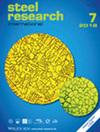Characterization of CrMnNi Steel Powders Obtained via Gas Atomization
IF 1.9
3区 材料科学
Q2 METALLURGY & METALLURGICAL ENGINEERING
引用次数: 0
Abstract
To obtain a successful product during additive manufacturing, the powder as a raw material must have the high quality. The purpose of this work is to investigate CrMnNi steel powders obtained by inert gas atomization with nickel content: 3, 6, and 9 wt% and to identify dependencies between the powder size and morphology, solidification structure, and change in chemical composition and thermophysical properties. Particle size distribution is measured by a laser scattering analyzer: d通过气体雾化技术获得的铬锰镍钢粉的表征
要在增材制造过程中获得成功的产品,作为原材料的粉末必须具有高质量。这项工作的目的是研究通过惰性气体雾化获得的镍含量为 3、6 和 9 wt% 的铬锰镍钢粉末,并确定粉末尺寸和形态、凝固结构以及变化之间的关系:3、6 和 9 wt% 的铬锰镍钢粉末,并确定粉末尺寸与形态、凝固结构以及化学成分和热物理性能变化之间的关系。使用激光散射分析仪测量了粒度分布:镍含量为 3、6 和 9 wt% 的粉末的 d50 值分别为 82.02、69.32 和 75.54 μm。采用最大气泡压力法测定了表面张力(ST):在温度为 1500 °C 的条件下,3、6 和 9 wt% 的钢材的 ST 值分别为 1.01、1.07 和 1.15 mN m-1。研究发现,粒度的变化会影响化学成分、铁磁相含量和二级树枝状臂间距。S、O、N 和 Mn 等元素含量的变化取决于颗粒的直径。研究了 S、O 和 N 含量的变化对 ST 等热物理性质的影响。
本文章由计算机程序翻译,如有差异,请以英文原文为准。
求助全文
约1分钟内获得全文
求助全文
来源期刊

steel research international
工程技术-冶金工程
CiteScore
3.30
自引率
18.20%
发文量
319
审稿时长
1.9 months
期刊介绍:
steel research international is a journal providing a forum for the publication of high-quality manuscripts in areas ranging from process metallurgy and metal forming to materials engineering as well as process control and testing. The emphasis is on steel and on materials involved in steelmaking and the processing of steel, such as refractories and slags.
steel research international welcomes manuscripts describing basic scientific research as well as industrial research. The journal received a further increased, record-high Impact Factor of 1.522 (2018 Journal Impact Factor, Journal Citation Reports (Clarivate Analytics, 2019)).
The journal was formerly well known as "Archiv für das Eisenhüttenwesen" and "steel research"; with effect from January 1, 2006, the former "Scandinavian Journal of Metallurgy" merged with Steel Research International.
Hot Topics:
-Steels for Automotive Applications
-High-strength Steels
-Sustainable steelmaking
-Interstitially Alloyed Steels
-Electromagnetic Processing of Metals
-High Speed Forming
 求助内容:
求助内容: 应助结果提醒方式:
应助结果提醒方式:


